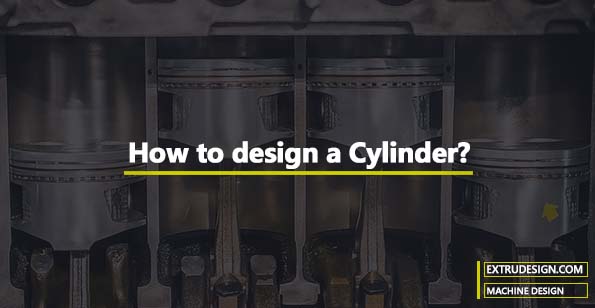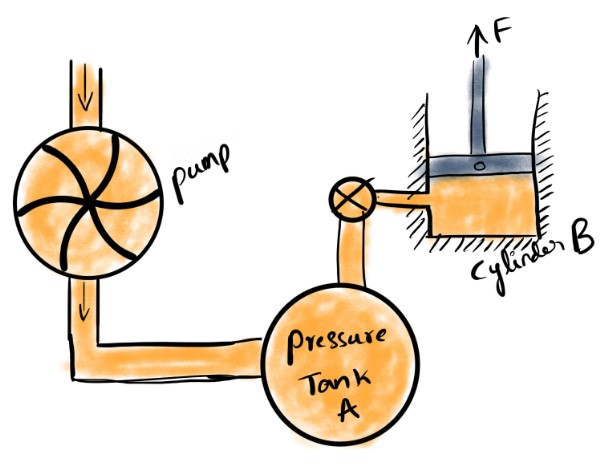Have you ever wondered how to design a Cylinder?? I mean how the basic parameters such as diameter and thickness are set. We mostly see Cylinders in Internal combustion Engines, Compressors, and Hydraulic pumps. In all these cases the Cylinder will experience internal pressure caused by combustion in engines, air compressed by the piston in the compressors, or fluid pressure in the hydraulic pumps. So it is necessary to understand the influence of this internal pressure while designing a Cylinder. We have already discussed the different pressures induced in the cylindrical shells. In this article, we will discuss a Cylinder design by solving a simple problem on a Hydraulic control.

Problem Statement: Hydraulic control for a straight-line motion, as shown below, utilises a spherical pressure tank ‘A’ connected to a working cylinder B. The pump maintains a pressure of 3 N/mm2 in the tank.

Q1. If the diameter of pressure tank is 800 mm, determine its thickness for 100% efficiency of the joint. Assume the allowable tensile stress as 50 MPa.
Answer:
The given data
Pressure to be maintained in the pressure tank (p) = 3 N/mm2
Diameter of the Pressure Tank (d) = 800mm
The circumferential Joint Efficiency (η) = 100% = 1
Allowable Tensile Stress of Pressure Tank (σt1)= 50MPa
The Thickness of the pressure tank is t = (p × d)/(2σt1×ηl) (From here)
t = (3×800)/(2×50×1) = 24
The Thickness of the pressure tank is (t) = 24mm
Q2. Determine the diameter of a cast-iron cylinder and its thickness to produce an operating force F = 25 kN. Assume
- An allowance of 10 per cent of operating force F for friction in the cylinder and packing, and
- A pressure drop of 0.2 N/mm2 between the tank and cylinder. Take safe stress for cast iron as 30 MPa.
Answer:
Given data
The operating force (N) = 25 × 103 N
Safe stress for cast iron material (σtc) = 30 MPa = 30 N/mm2
Let us consider D as the diameter of the Cylinder and t1 is the thickness of the cylinder.
As it is mentioned in the problem statement that the allowance of 10 percent of operating force F is provided for friction in the cylinder and packing, therefore the total force is to be produced by friction.
Total operating force F1= 100%+10% =110% of 25 × 103 N = 1.1 × 25 × 103= 27.5 × 103N
Total operating force F1= 27.5 × 103N
And also mentioned that a pressure drop of 0.2 N/mm2 between the tank and cylinder in the problem statement, therefore the pressure in the cylinder will be
p1 = Pressure in the Tank – Pressure drop = 3-0.2 = 2.8N/mm2
The total force produced by friction (F1) will be
27.5 × 103 = (π /4)× D2 × p1 = 0.7854 × D2 × 2.8 = 2.2 D2
2.2 D2 = 27.5 × 103
D = 112 mm
Diameter of the cast-iron Cylinder is (D) = 112 mm
We know the thicknesses of the cylinder t1 = (p1 × D)/2σtc (from longitudinal stresses here)
= (2.8 ×112)/(2×30) = 5.5mm
The Cast iron Cylinder thicknesses can be (t1) 5.5mm
Q3. Determine the power output of the cylinder, if the stroke of the piston is 450 mm and the time required for the working stroke is 5 seconds.
Answer:
Given Data
The stroke of the piston = 450 mm = 0.45 m
The time required for the working stroke = 5 seconds
∴Distance moved by the piston per second = 0.45/5 = 0.09 m
We know that work done per second = Force × Distance moved per second
= 27.5 × 103 × 0.09 = 2475 N-m (∴ 1 N-m/s = 1 W)
∴ The power output of the cylinder = 2475 W = 2.475 kW
Q4. Find the power of the motor, if the working cycle repeats after every 30 seconds and the efficiency of the hydraulic control is 80% and that of the pump 60%.
Answer:
Given data
Since the working cycle repeats after every 30 seconds, therefore the power which is to be produced by the cylinder in 5 seconds is to be provided by the motor in 30 seconds.
∴ Power of the motor = (Power of the cylinder/(ηH×ηP))×(5/30)
(2.475/(0.8)×(0.6))×(5/30) = 0.86kW
Power of the motor = 0.86kW
Would you like to solve a problem on your Own?
I got 3 exercises for you.
- A steam boiler, 1.2 metre in diameter, generates steam at a gauge pressure of 0.7 N/mm2. Assuming the efficiency of the riveted joints as 75% , find the thickness of the shell. Given that ultimate tensile stress = 385 MPa and factor of safety = 5.
- Find the thickness of a cast iron cylinder 250 mm in diameter to carry a pressure of 0.7 N/mm2. Take maximum tensile stress for cast iron as 14 MPa.
- A pressure vessel has an internal diameter of 1 m and is to be subjected to an internal pressure of 2.75 N/mm2 above the atmospheric pressure. Considering it as a thin cylinder and assuming the efficiency of its riveted joint to be 79%, calculate the plate thickness if the tensile stress in the material is not to exceed 88 MPa.
Solve these exercise problems and let me know the answers in the comment section below. I will help you.

Leave a Reply